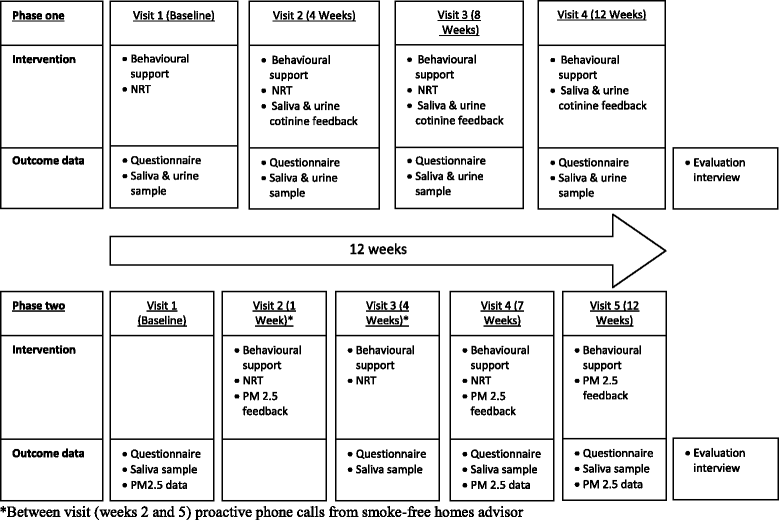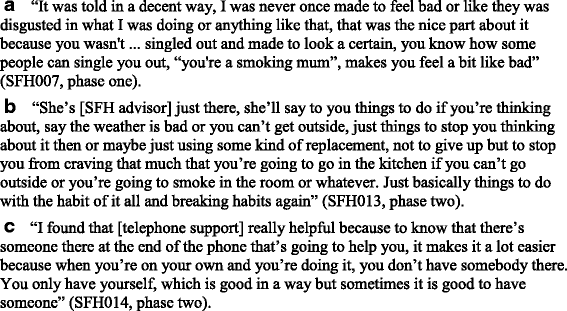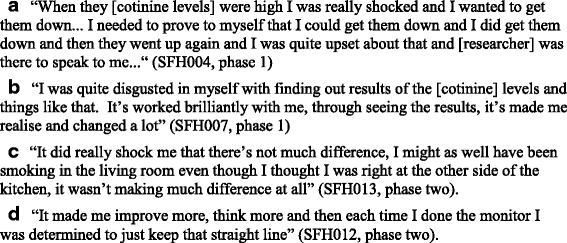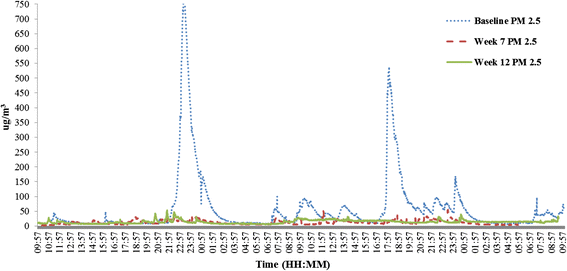Protecting children from secondhand smoke: a mixed-methods feasibility study of a novel smoke-free home intervention
- PMID: 27965870
- PMCID: PMC5153871
- DOI: 10.1186/s40814-016-0094-7
Protecting children from secondhand smoke: a mixed-methods feasibility study of a novel smoke-free home intervention
Abstract
Background: Globally, 40 % of children under 14 years are regularly exposed to secondhand smoke (SHS), typically in their homes. There is limited evidence of the effectiveness of interventions to reduce children's SHS exposure, and so the aim of this study was to test the feasibility and acceptability of a novel intervention to help parents and carers (caregivers) to reduce their children's exposure to SHS at home.
Methods: A novel multi-component intervention to support caregivers to reduce their children's SHS exposure at home was tested in a two-phase feasibility study. The 12-week intensive intervention delivered in the home consisted of three components: behavioural support, nicotine replacement therapy (NRT) for temporary abstinence and feedback on levels of SHS exposure in the form of children's salivary cotinine (phase 1) or home air quality (PM2.5) (phase 2). Participants were caregivers who smoked inside their homes and had at least one child under the age of 5 years living with them the majority of the time. Mixed-methods were used to explore the acceptability and feasibility of the intervention as well as processes, particularly around recruitment and retention, for an exploratory efficacy trial.
Results: Twelve caregivers completed the study, all received personalised feedback on SHS exposure and behavioural support to help them to make their homes smoke-free and the majority at least tried NRT. Saliva cotinine results were variable in phase 1, and therefore, measures of PM2.5 were used for feedback in phase 2. Behavioural support was well received with personalised feedback reported as being the key motivator for initiating and maintaining behaviour change.
Conclusions: Recruiting disadvantaged caregivers was labour intensive, but once recruited, this novel intervention was both feasible and acceptable in supporting caregivers to reduce their children's exposure to SHS at home. It is appropriate to test the efficacy of this novel intervention in an exploratory randomised controlled trial.
Trial registration: This is not applicable for the current study; however, a registered exploratory randomised controlled trial linked to this manuscript is currently ongoing (ISRCTN81701383).
Keywords: Acceptability; Complex intervention; Feasibility study; Mixed-methods; PM2.5; Recruitment; Secondhand smoke; Smoke-free homes.
Figures






Similar articles
-
A randomised controlled trial of a complex intervention to reduce children's exposure to secondhand smoke in the home.Tob Control. 2018 Mar;27(2):155-162. doi: 10.1136/tobaccocontrol-2016-053279. Epub 2017 Apr 21. Tob Control. 2018. PMID: 28432210 Free PMC article. Clinical Trial.
-
REFRESH--reducing families' exposure to secondhand smoke in the home: a feasibility study.Tob Control. 2013 Sep;22(5):e8. doi: 10.1136/tobaccocontrol-2011-050212. Epub 2012 May 21. Tob Control. 2013. PMID: 22615325 Clinical Trial.
-
Cost-effectiveness of a complex intervention to reduce children's exposure to second-hand smoke in the home.BMC Public Health. 2018 Nov 13;18(1):1252. doi: 10.1186/s12889-018-6140-z. BMC Public Health. 2018. PMID: 30424742 Free PMC article. Clinical Trial.
-
Impact of Public Smoking Bans on Social Inequalities in Children's Exposure to Tobacco Smoke at Home: An Equity-Focused Systematic Review.Nicotine Tob Res. 2019 Oct 26;21(11):1462-1472. doi: 10.1093/ntr/nty139. Nicotine Tob Res. 2019. PMID: 29986089
-
Effectiveness of a School-Based 'Tobacco Free' Intervention on Adolescents' Knowledge and Exposure to Second Hand Tobacco Smoke - A Multiphase Study.Asian Pac J Cancer Prev. 2019 Dec 1;20(12):3533-3537. doi: 10.31557/APJCP.2019.20.12.3533. Asian Pac J Cancer Prev. 2019. PMID: 31870091 Free PMC article. Review.
Cited by
-
Using air quality monitoring to reduce second-hand smoke exposure in homes: The AFRESH feasibility study.Tob Prev Cessat. 2017 Jun 22;3:117. doi: 10.18332/tpc/74645. eCollection 2017. Tob Prev Cessat. 2017. PMID: 32432192 Free PMC article.
-
Efficacy and cost-effectiveness of a community-based smoke-free-home intervention with or without indoor-air-quality feedback in Bangladesh (MCLASS II): a three-arm, cluster-randomised, controlled trial.Lancet Glob Health. 2021 May;9(5):e639-e650. doi: 10.1016/S2214-109X(21)00040-1. Lancet Glob Health. 2021. PMID: 33865472 Free PMC article. Clinical Trial.
-
Interventions to encourage smoke-free homes in remote indigenous Australian communities: a study protocol to evaluate the effects of a community-inspired awareness-raising and motivational enhancement strategy.BMJ Open. 2018 Mar 2;8(3):e018955. doi: 10.1136/bmjopen-2017-018955. BMJ Open. 2018. PMID: 29500205 Free PMC article.
-
Development of a Smoke-Free Homes Intervention for Parents: An Intervention Mapping Approach.Health Psychol Bull. 2019;3(1):67-86. doi: 10.5334/hpb.20. Epub 2019 Dec 19. Health Psychol Bull. 2019. PMID: 32337370 Free PMC article.
-
Supporting Parents Living in Disadvantaged Areas of Edinburgh to Create a Smoke-Free Home Using Nicotine Replacement Therapy (NRT): A Two-Phase Qualitative Study.Int J Environ Res Public Health. 2020 Oct 7;17(19):7305. doi: 10.3390/ijerph17197305. Int J Environ Res Public Health. 2020. PMID: 33036327 Free PMC article.
References
Grants and funding
LinkOut - more resources
Full Text Sources
Other Literature Sources

